Diversity and Equity
Science Club
Bridging In-School and Out-of-School STEM Learning Through a Collaborative, Community-Based After-School Program
Connected Science Learning March 2016 (Volume 1, Issue 1)
By Michael Kennedy, Rebecca Daugherty, Cecilia Garibay, Camellia Sanford, Jennifer Koerner, Jennifer Lewin, and Rosemary Braun
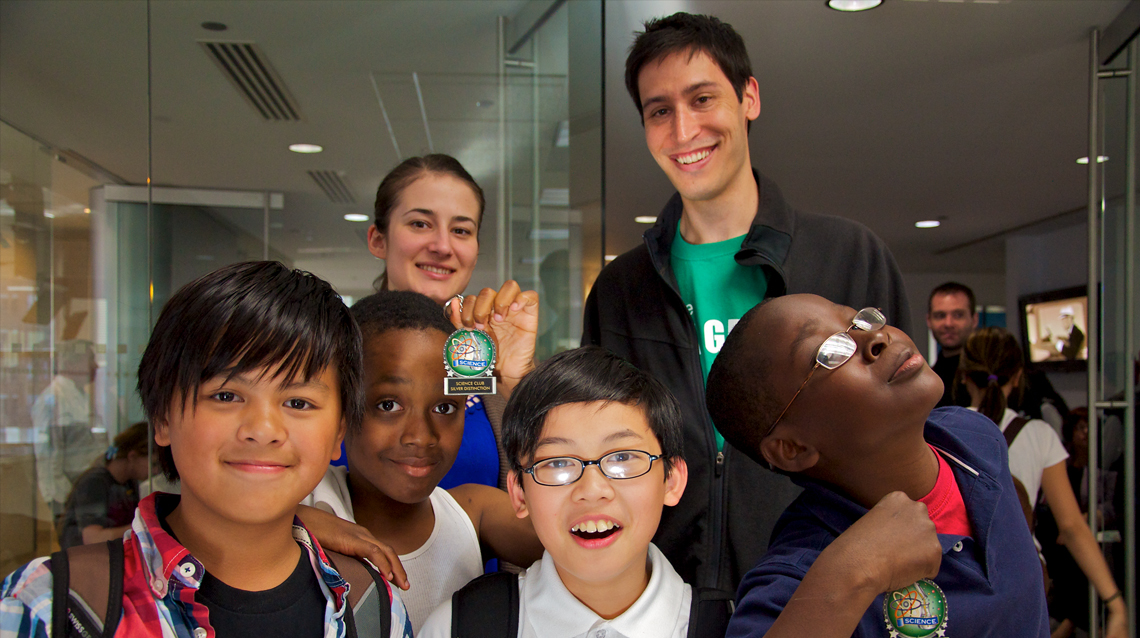
Science Club is a new, mentor-based after-school program for underserved middle school youth. It is designed to address the gaps described above by connecting in-school and out-of-school learning. Through weekly, inquiry-based, small-group instruction in a dedicated laboratory setting at a Boys & Girls Club in Chicago, youth build authentic science skills and receive the support of scientist-mentors.
For decades, K–12 science education researchers have echoed the need for inquiry-based teaching approaches to connect students to real scientists and science environments (AAAS 1989; NRC 1996, 2007). The Next Generation Science Standards (NGSS) amplify these needs by stressing the importance of student-developed conceptual models to explain real-world phenomena and coherent integration of authentic science practices, concepts, and core ideas across grade levels (NRC 2012; NGSS Lead States 2013).
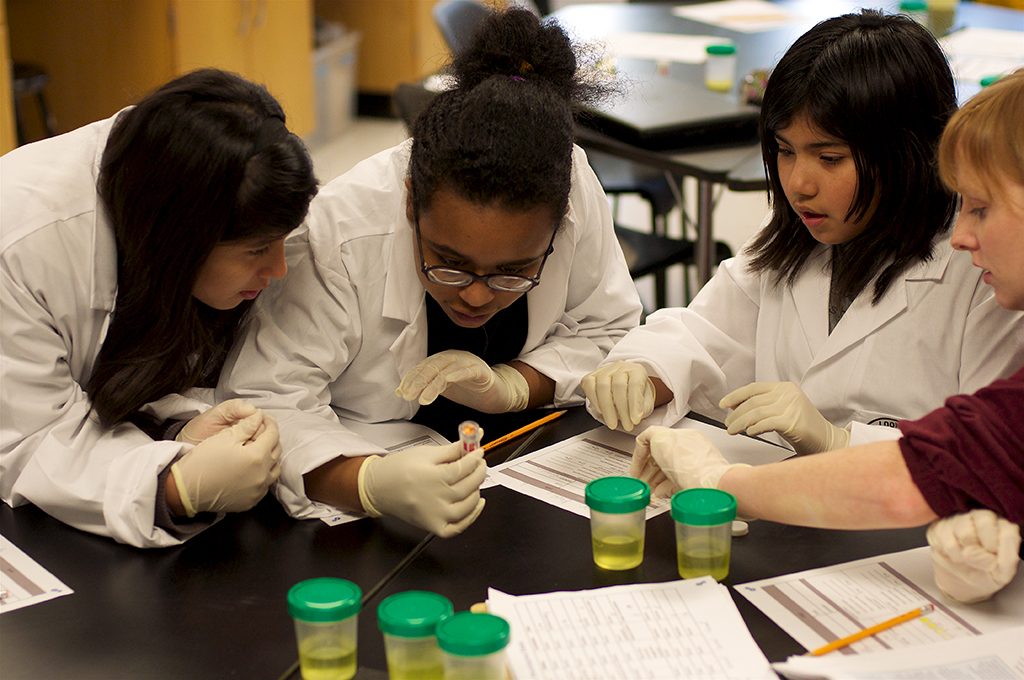
Implementation of these ideals in the classroom, however, has faced well-documented challenges—especially at the elementary and middle levels. Few generalist elementary teachers have formal science training (Banilower et al. 2013), and many professional development programs for teachers fall short of the required depth and breadth needed to be effective (Capps, Crawford, and Constas 2012; Loucks-Horsley et al. 2010; Luft, Wong, and Ortega 2009). The most fundamental need—sufficient inquiry-based instructional time—has fallen victim to an increased emphasis on maximizing time spent on math, language arts, and preparation for standardized testing.
For urban public schools, these challenges are compounded by the effects of chronic poverty. High rates of student mobility and cultural diversity, combined with low literacy rates, push the concept of differentiated instruction to the extreme (Santamaria 2009; Tomlinson and McTighe 2006; Popp, Grant, and Stronge 2011). Many urban schools are significantly under-resourced, lacking the supplies, classroom and school environment, and culturally appropriate teaching methods necessary for effective science instruction (MacIver et al. 2001; NRC and Institute of Medicine 2004; Young 2005; Luehmann and Markowitz, 2007; Spillane et al. 2001; Teel, Debruin-Parecki, and Covington 1998).
Thus, there exists a clear opportunity for schools, community partners, and STEM-rich institutions to collaboratively develop programs to address these needs.
Program Design
Science Club is a new, mentor-based after-school program for underserved middle school youth. It is designed to address the gaps described above by connecting in-school and out-of-school learning. Through weekly, inquiry-based, small-group instruction in a dedicated laboratory setting at a Boys & Girls Club in Chicago, youth build authentic science skills and receive the support of scientist-mentors.1
Founded in 2008, Science Club was collaboratively developed and continues to be overseen by members of three core organizations: science teachers from Chicago Public Schools (CPS), staff at the Pedersen-McCormick Boys & Girls Club of Chicago, and faculty and staff from Northwestern University (see Table 1). The program serves youth in grades 5–8, recognizing the middle school years as both a critically important time for foundational STEM career aspirations (Tai et al. 2006; Maltese and Tai 2010) and a time when girls are at risk for losing interest in science (Barton, Tan, and Rivet 2008).
Table 1. Science Club’s Integrated Partnership
The table highlights select roles for Science Club partner groups, as aligned to Gil Noam’s “Quality Triangle” for after-school programming (Noam, Biancarosa, and Dechausay 2003; Noam 2008).
| Leadership and Support | Training and Capacity | Curriculum and Activities | |
|---|---|---|---|
| CPS Teachers | Codeveloped Science Club programmatic framework. Frequently communicates with NU leadership regarding specific student needs, program direction, and youth recruiting and retention. Partners with NU for fundraising, irrespective of organization receiving funds. | Trains faculty, staff, and mentors in educational best practices. Participates in quarterly mentor training/professional development sessions, running small group workshops on youth development, engagement strategies, etc. Serves as resource to address specific youth pedagogical or behavioral issues. | Codevelops and advises on curriculum and instructional approaches. Codeveloped six curricular modules with NU. Provides ongoing feedback and support for new module development, including specific areas of emphasis on which Science Club curricula should focus (e.g., experimental design, data analysis, writing). |
| Pedersen-McCormick Boys & Girls Club | Manages facilities, staff, and youth recruitment. Provides physical space for Science Club. Recruits youth. Supervises half-time staff member to help run program. Assists with fundraising. Lobbied with Northwestern to reverse NIH decision to end K–12 education funding. | Trains faculty, staff, and mentors in youth development. Trains Northwestern faculty, staff, and mentors on cultural awareness and keys for success in an after-school space. Participates in quarterly mentor training/professional development sessions. | Integrates science education into the club culture. Identifies opportunities for Science Club to support or learn from with other club initiatives (e.g., Science Club collaborates with gardening program; leveraged culinary and dietetic expertise of gardening program for “Science of Food” unit). |
| Northwestern University (NU) Staff and Faculty | Led programmatic development, fundraising, and evaluation. Leadership for Science Club development, fundraising, and ongoing support for teachers, mentors, and club staff. Manages human subjects research/Institutional Review Board (IRB) and evaluation responsibilities. | Provide CPS teachers and Boys & Girls Clubs with access to science faculty, mentors, and resources. Runs annual science fair judging for partner schools (i.e., recruits and trains NU scientists to judge 100–300 projects per school). In partner CPS school, renovated classroom to include donated lab benches and cabinetry. Works with broader Boys & Girls Clubs of Chicago admin team to develop broader strategy for STEM programming and associated evaluation approaches (e.g., tracking students longer-term). | Primary responsibility for curriculum design and implementation. Provides CPS classroom support for partner schools, including field trips, loaner or donated supplies, and in-class volunteers or substitute teachers as needed. For Boys & Girls Club, hires high school-age Science Club alumni to serve as mentors during Science Club sessions and during summer science camps. Helps with broader club fundraising needs. |
| Northwestern University (NU) STEM Student Mentors | Teach and mentor youth. Serve as leaders for their small groups (two mentors with four youth). Provide youth with broad academic and noncognitive skill support. | Peer-led training and professional development. | Differentiate instruction for Science Club youth. All mentors are charged with responsibility of adapting curricula to meet their group’s learning needs and aptitude. Senior mentors help revise existing and develop new curricula. |
| Senior mentors play important training roles in new mentor onboarding and quarterly professional development events. |
The benefits of developing the program for after-school hours are many, especially for STEM disciplines (Krishnamurthi, Ballard, and Noam 2014; Afterschool Alliance 2014). After school is an ideal time for mentoring—a highly effective approach for teaching academic behaviors that lead to long-term academic success (DuBois et al. 2002; Sipe 2002; Hurd et al. 2012; Moodie and Fisher 2009), including success in STEM disciplines (Beck et al. 2006; Scogin and Stuessy 2015). In fact, a 2009 survey of high school students’ interest in STEM careers revealed that two-thirds of students were not considering a career in science because they either did not understand what scientists do or did not have a mentor in science (MIT 2009).
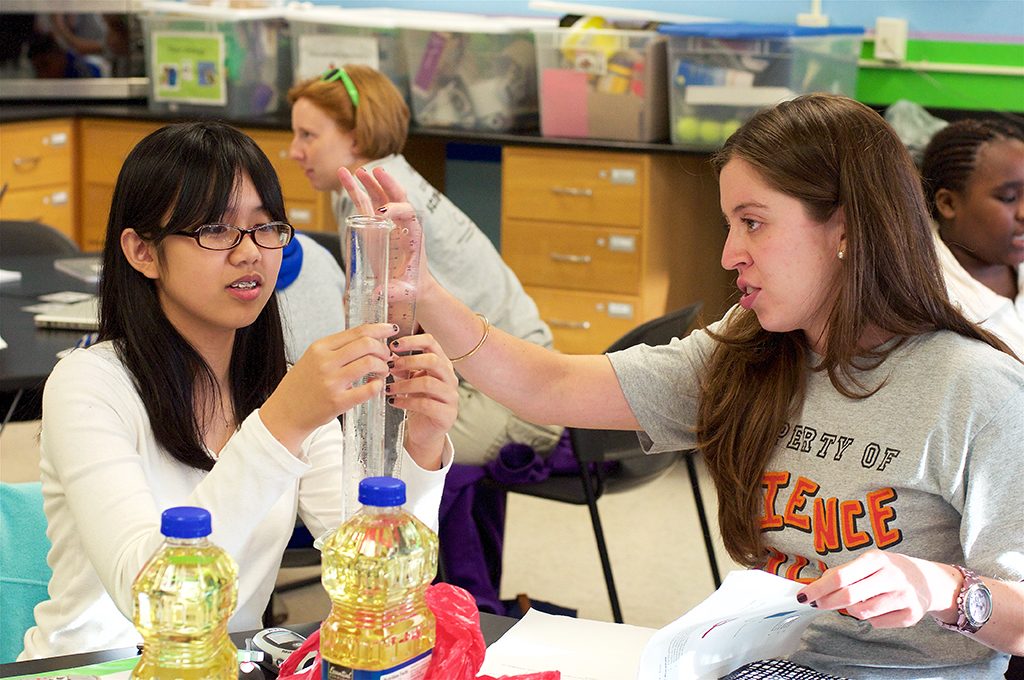
At its core, Science Club is designed to foster mentoring relationships between youth and science professionals (i.e., Northwestern University graduate students from a variety of STEM disciplines, including chemistry, biology, engineering, and neuroscience). The relationship between mentor and mentee is bidirectional. Mentors teach STEM skills while learning new approaches to science teaching and communicating with the youth they serve (Tenenbaum et al. 2014).
The Science Club mentorship model is small group–based. Two Northwestern scientist-mentors each work with four middle school students as a collaborative team. Mentor-student pairings are formed using input from teachers and Boys & Girls Club staff, factoring in youth aptitude, social circles, and personality. These pairings strengthen over time, as mentors and youth spend well over one year, on average, in the program.
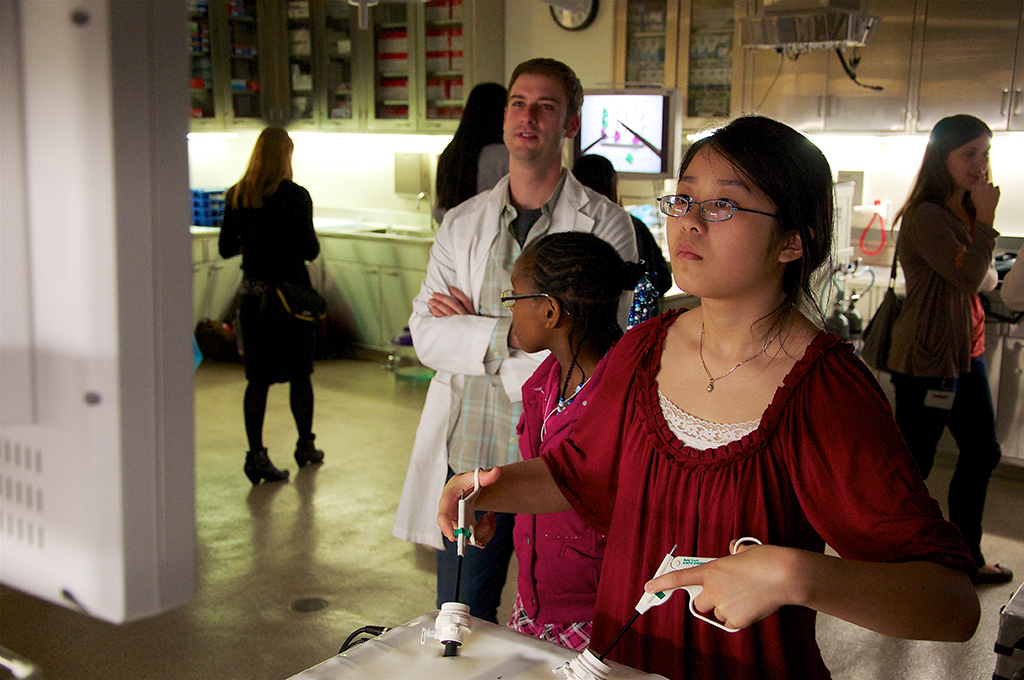
Small groups independently work through the Science Club curricula. Six health- and biomedicine-focused curricular modules have been developed, covering topics from biomedical engineering to food science (see Curricular Vignette). Each module is designed around a Grand Challenge, which stresses connections to authentic science challenges and environments (Crawford 2012; Bransford, Brown, and Cocking 1999) (see Table 2). The modules include six to eight weekly lessons of 90 minutes each. Lessons are flexible enough to be implemented with students ranging from low-performing fifth graders to high-performing eighth graders. Mentors assume responsibility for structuring each lesson to meet their group’s unique mix of aptitudes and interests. In addition to a strong focus on inquiry and experimentation, each lesson period is structured to provide time for academic check-ins and informal discussion about topics of the group’s choosing, both of which are critically important for developing mentoring relationships. Each quarter culminates with a final event, during which students have a chance to present the results of their investigations to other Science Club members and mentors, the broader Boys & Girls Club membership, and their families.
Table 2. Science Club Curricular Alignment to Grand Challenges and to Select NGSS Disciplinary Core Ideas
| Science Club Curriculum | Grand Challenge | NGSS Disciplinary Core Idea | NGSS Practices |
|---|---|---|---|
| Science of Food | Conduct cooking experiments with the goal of designing healthier versions of kids’ favorite junk foods. | Grade 5 Physical Science (5-PS1-1 and 5-PS1-3) | Asking Questions and Defining Problems; Planning and Carrying Out Investigations |
| Science: The Movie! | Apply knowledge of the science of sound to record a new soundtrack for a movie clip. | Middle School Physical Science (MS-PS4-1 and MS-PS4-2) | Analyzing and Interpreting Data |
| Medical Mystery | Diagnose an illness in a fictional girl using four types of medical tests. | Middle School Life Science (MS-LS1-1 through MS-LS1-4) | Using Mathematics |
| Clean Water Challenge | Identify water contaminants and design a water filter to remove the pollutants. | Middle School Engineering MS-ETS1-1 through MS-ETS1-4) | Engaging in Argument from Evidence |
| NeuroSports | Develop and test neurology-based approaches to help improve athletic performance. | Middle School Life Science (MS-LS1-1 through MS-LS1-4) | Constructing Explanations and Designing Solutions |
| Get a Grip! | Design a prosthetic limb for a fictional girl in Afghanistan. | Middle School Engineering (MS-ETS1-1 through MS-ETS1-4) | Obtaining, Evaluating, and Communicating Information |
Each fall quarter is dedicated to supporting students’ mandatory school science fair projects. Mentors help Science Club members refine their ideas for projects, design sound methodology, and collect and analyze data. This support has turned out to be an invaluable resource for teachers, who are normally charged with managing over 30 independent projects per classroom.
As of January 2016, the program supports 100 youth at two Chicago-area Boys & Girls Clubs, mentored by 50 STEM graduate students at Northwestern University and the University of Illinois at Chicago.
Connections to the NGSS
Although current Science Club curriculum modules were largely developed and refined prior to the release of the NGSS (NGSS Lead States 2013), there are multiple levels of synergy between the two. First, the overarching focus on weekly, direct connection to authentic scientists and science environments allows youth to learn firsthand about the nature of scientific inquiry; that is, science and engineering are iterative processes of discovery, failure and unexpected results are part of learning, and the process of answering interesting scientific questions does not fit neatly into 45-minute class periods.
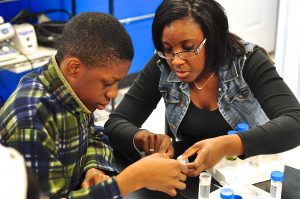
A second level of synergy is the grounding of all Science Club curricular modules in real-world phenomena and scenarios. The curriculum was designed from a youth-centered view. Themes for each curriculum module were informed by input from the students, teachers, and Boys & Girls Club staff. Youth explore a wide range of phenomena, ranging from “What is sound?” to “filtration of different-sized particles from water” to “What makes pancakes so fluffy?” Throughout the lessons, Science Club teaches youth that science and engineering can be used to solve problems and gain a greater understanding of the world around them. Each weekly lesson provides youth with the opportunity to reflect on their experiences, collect new data and information, and, with their group, build a more sophisticated model of understanding. This format is open-ended and allows youth to take more ownership of their learning.
Third, all units are built with authentic science practices at their core. This is in direct alignment with the eight NGSS scientific practices (see Table 2) Even literacy skills are strongly integrated into our pedagogical approach, with students drafting online “journal posts” detailing their scientific question and methodological approach to testing the question, data and results, and next steps (for example journal posts, see https://scienceclub.northwestern.edu/journal). Additionally, quarterly “finale” events with the broader Boys & Girls Club membership provide Science Club youth with the opportunity to share the results of their investigations with their peers.
Because Science Club caters to such a wide range of grades, it is impractical to intentionally align our curriculum to NGSS disciplinary core ideas, which are topic- and grade-specific. However, because the program emphasizes authentic science practices and real-world scenarios, the Science Club curriculum naturally incorporates many of the core ideas described in NGSS.
Finally, for assessment, we have developed an authentic method to measure student learning of NGSS practices. As described in the Youth Impact section, we have partnered with local schools to use their annual science fair and accompanying oral judging process to measure skills achievement for Science Club youth versus youth in a control group.
Youth Impact: Evaluation
The change that I saw [in Science Club members] was they were able to… [back] up their answers with evidence, and really … think like a scientist in order to make an attempt at answering the questions. —CPS teacher
Although many educators focus on science content and skills as the determinants of STEM success, there is a second, equally important factor for long-term STEM engagement: students identifying themselves as legitimate members of a science community (Barton, Tan, and Rivet 2008; Buxton 2005; Aikenhead and Jegede 1999). Science Club effectively integrates both components.
Science Club’s external evaluation used a mixed-methods approach (Greene and Caracelli 1997) to assess impact on both skills and science identity. The results summarized in this section are intended as a high-level overview of our more detailed findings, emphasizing participants’ first-hand perspectives.
Science Club’s curricular modules are designed to increase youth understanding of the scientific approach (i.e., developing a testable question, designing an appropriate methodology, controlling variables, accounting for experimental error), as well as teamwork and collaboration. This focus is integrated into each weekly session, offering plenty of opportunities for idea refinement and iterative learning. A mentor commented, “Last week, we started working on a second project investigating detergents and stain removal. I saw real progress with the girls. I was emphasizing concepts of variables and constants. By the second exercise, both girls were able to chime in and name all the important things to keep constant and how it was important to have only one variable.” One youth member wrote, “[Another skill is] being able to work with others, because the program isn’t individual-based. You’re working with other people, working in teams, and using their different observation and perspective and merging it with yours.”
School Science Fair: An Authentic, Rigorous Method to Assess Student Skills
To be respectful of the “no test” culture in after-school environments, we used the annual CPS science fair to evaluate youth understanding and application of science skills. Each fall, all CPS students in grades 6–8 complete a science fair project. These projects are presented orally to a judge and scored using a CPS-wide rubric designed to assess student understanding of a variety of NGSS-aligned skills (see Resource).
From 2010 to 2013, we used independent, scientist judges to score a total of 451 science fair projects for youth in grades 6–8 at three separate CPS elementary schools. Both Science Club members and non–Science Club youth were among the 451. Two judges independently scored each student’s presentation, blind to Science Club participation.
To account for the strong predictive relationship between students’ science fair score and their entering aptitude, each student’s science teacher provided a science “aptitude rating,” a 1–3 ranking of the child’s academic strength in science (3 = highest ability, 2 = middle ability, 1 = lowest ability). This score allowed the project team to conduct statistical analyses in which each student’s relative aptitude is factored into the analysis, allowing a more precise estimate as to the effect of Science Club participation, independent of entering aptitude.
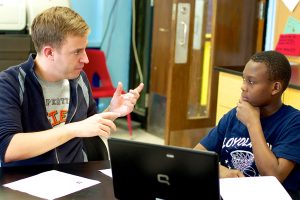
Multivariate regression analysis was used to investigate the relationship between the science fair score and the following covariates: gender, aptitude, grade level, school attended, and Science Club participation. This method allows the effect of Science Club participation to be isolated, while adjusting for the effects of entering aptitude, school, and gender.
The results indicate that Science Club participation results in strong science-skills gains across all student aptitude categories and grade levels. The effect of Science Club participation is equivalent in magnitude to shifting a student up one full aptitude level (e.g., low to middle, middle to high) and was strongly statistically significant (p < 10-10) for students of all entering aptitudes, gender, school, and grade level. This result is supported by independent teacher interviews regarding Science Club–youth skills and by preliminary data from a separate, interview-based skills assessment given to participating and control youth on an annual basis.
Youth Science Identity and Community
Building science identity starts with engagement and participation. Analysis of six years of youth attendance data revealed average attendance rates of more than 80% and 1.3 years of participation. For a population of students in which more than 90% are eligible for a free or reduced lunch, yearly mobility rates are as high as 40% (four in 10 students will change schools during the year), and eight in 10 of youth come from single-caregiver households, the high attendance and retention rate are indicative of strong engagement.
Youth focus groups and interviews conducted as part of the project evaluation confirmed Science Club members’ engagement and overwhelmingly positive feelings about their experience. Members clearly identified themselves as part of an academic, social, and emotional support system that included peers, scientist-mentors, and Science Club staff. In interviews, youth often named the social and supportive environment as an important factor in their enjoyment of Science Club. One youth noted, “They make me feel like I matter.” Another participant said the community is integral in “Pushing me and keeping my drive and that hope, that fire lit, to keep going.” This support played a critical role in participants’ academic and social development in middle school, high school, and beyond. For example, Science Club leaders regularly help students with applications to and full-ride scholarships for selective-enrollment high schools, provide paid “high school mentor” positions to program alumni, and assist college-age alumni in finding summer internships.
Through their Science Club relationships, youth developed a deep appreciation for working on projects with their peers and mentors. They shared that Science Club allowed them to learn in interactive ways through their experiments and actively do science without feeling the pressure to always have the right answer or get good grades. As one club member explained, “I always kind of knocked myself down when I didn’t do good. But Science Club allowed me to understand that there are times where errors are made. … And all you have to do is reprogram yourself to do it better the next time. … What do we have to do in the experiment so that we get the results that we are looking for? And I took that mentality and that idea out of Science Club and put that into my life.”
Science Club youth also emerged with broader conceptions of science. They came to see science as something fun and exciting. Youth developed greater understanding of and appreciation for the kinds of questions science can answer and the impact it can have on their own lives and society as a whole. For example, they learned that science is not just “another subject you learn in school” but rather a way of answering vital questions, solving problems, keeping people safe, and helping people live better lives. During the project’s formative evaluation, 100% of the Science Club youth who were enrolled for three quarters (one year) identified science as important to their future career choice, compared to just 70% of control youth. Interestingly, Science Club participants’ universal recognition that science is important for their future career choice includes a high percentage of students interested in non-STEM careers, including ones in the sports and entertainment field. Youth interested in sports and entertainment were still able to clearly and specifically articulate how science plays a role in their respective career area. For example, students aspiring to a career in professional sports cited the importance of nutrition for performance and for shooting a basketball along the proper arc to maximize the probability of making a basket. These types of specific, informed responses were not seen with any control or pre–Science Club youth.
Science Club also enabled those who wanted to pursue STEM careers to acquire more realistic ideas about what it means to be a scientist and to learn about options they could pursue. A mentor commented, “One of the most rewarding moments for me was last quarter[ when] one of the girls in my group said, ‘So you’re a real scientist. How did you get to where you’re at?’… it is really cool to see that they are actually interested in science and that they might be interested in getting there.”
Furthermore, evidence is mounting that Science Club participation has a strong positive effect on long-term STEM career pathways. From 2002–2012, the Pedersen-McCormick Boys & Girls Club tracked the postsecondary education path or career choice for approximately 100 of its members who graduated from high school. Only one pursued a postsecondary STEM career path (~1% from graduation years 2002–2012). Since 2012, when the first cohort of Science Club youth graduated from high school (the program started in spring 2008), 11 former Boys & Girls Club members are currently pursuing postsecondary STEM career paths, out of 32 high school graduates tracked clubwide (34%). All 11 are Science Club alumni. While this sample size of 32 students over the past three academic years represents a subset of the club’s broader high school graduates (estimated to be 25 per year × 3 years = 75 graduates), such an increase in STEM career choice is unprecedented in Boys & Girls Clubs of Chicago history. Through interviews with these 11 alumni, we learned Science Club played a critical, formative role in their STEM skill development, identity, and career awareness. We are working with Boys & Girls Club leadership to continue tracking students’ career progression as they move beyond postsecondary education and into full-time employment.
Program Challenges
Building Partnership and Establishing Trust
This partnership building process took time—more than a year. Initially, CPS teachers and administrators were understandably cautious about committing significant time and effort to the project, as their past “partnerships” with universities tended to be rather one-sided. Typically, teachers were asked to implement a curricular plan or approach developed by university researchers. Boys & Girls Club staff had similar experiences, with many partnerships being superficial and short-term. Throughout the first year, the Northwestern University team maintained a deep commitment to service and to learning from teachers and Boys & Girls Club staff. Northwestern focused on helping students and meeting their needs, rather than the needs of the university or granting agencies. Teacher perspectives on the partnership can be found with this article’s Resources.
Science Skills Evaluation in Informal, After-School Settings
Although measuring Science Club’s impact on youth attitudes and engagement was fairly straightforward, rigorously measuring changes in youth science skills proved significantly more challenging. In the initial phase of the program, we pilot-tested a new, multiple-choice youth science-literacy instrument developed by colleagues at Montclair State University (Fives et al. 2014). The assessment includes items designed to measure a variety of youth skills, including experimental design, data analysis, scientific reasoning, and controlling variables. However, in our informal club environment, this instrument was not a good fit. Youth cognitive interviews accompanying the pilot implementation revealed several significant issues with instrument validity. Although youth were able to orally articulate well-reasoned and appropriate answers to many questions, they often failed to select the proper answer when presented with a multiple-choice format. Low youth reading literacy and poor test-taking skills (e.g., failure to read all multiple-choice options) led to these inconsistent and invalid results. Furthermore, the environment in which the assessment was given (the Boys & Girls Club) was not appropriate for taking a “school-like” multiple-choice test. The disconnect between school-based and after-school assessment strategies is well-described in the literature (see Friedman 2008; Noam and Shah 2013). This led us to pursue more contextually relevant, interview-based approaches such as school science fairs. Although more labor intensive, this strategy has proven both valid and reliable in our after-school setting.
Starting a Science Club: Less Expensive Than You Think
Science Club started from very modest beginnings—a total budget of less than $3,000 and donated time from Northwestern faculty and graduate students. The program received a significant boost at the end of its second year from a five-year, $1.3 million Science Education Partnership Award from the National Institutes of Health (NIH). The overwhelming majority of this funding went to program development, curricular development, and evaluation.
With NIH funding now complete, Science Club’s maintenance budget is approximately $1,500 per child. This covers staffing costs (partial salary support for four staff), supplies, mentor transportation costs, and event costs (e.g., finale event each quarter, field trips). All STEM mentors volunteer their time (approximately two to three hours weekly), saving significant funds. A typical supply budget for a six- to eight-week curricular module is $200–$500 for 60 students, and many of the supplies are reusable. Current funding sources include philanthropic and corporate grants, as well as supply donations from local labs and scientific supply companies.
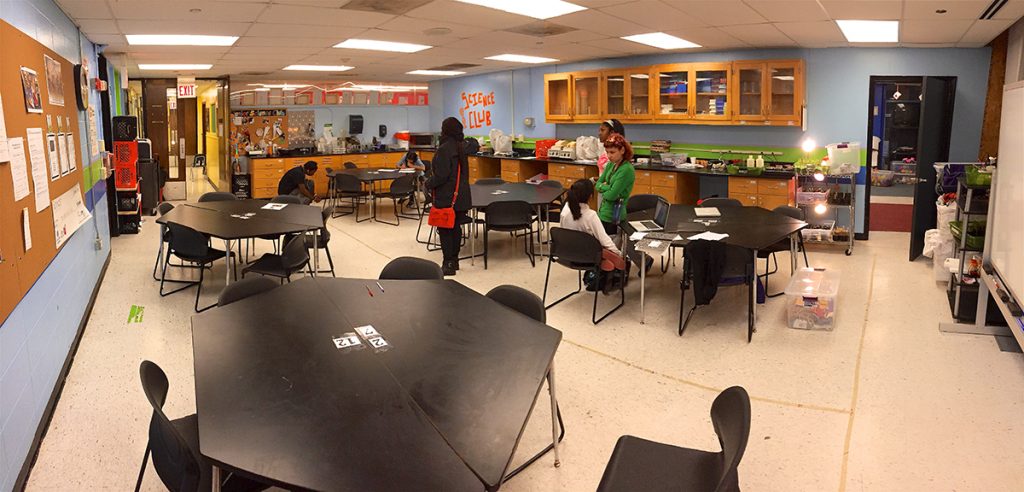
Benchmarking the Science Club budget, the average national cost of high-quality after-school programs ranges from approximately $1,500 to over $5,000 (Every Child Matters 2015; Grossman et al. 2009). Thus, Science Club and the broader Boys & Girls Club model represent tremendous value.
Can Science Club be implemented in a school-based setting? The short answer is yes. Ten CPS schools have implemented teacher-led Science Club curricula in school-based programs, and all of these schools have given positive feedback and repeated the offerings. The most challenging obstacle with the school-based model is identifying mentors. There simply are not enough Northwestern STEM students, or enough money to transport them across Chicago, to meet in-school demand. To address this issue, we have worked with teachers to encourage high school students—ideally, alumni of the middle school at which the program is to be implemented—to serve in these important mentoring roles. Asking program alumni to become mentors meets several needs. First, the presence of small-group leaders facilitates differentiated learning. Using high school mentors also provides their middle school mentees with much-needed information about the transition to high school, including increased academic demands and the strong time management and self-discipline skills needed for success. The transition from eighth to ninth grade is a time during which many students struggle (Rosenkranz et al. 2014). The high school mentors also benefit through their role as instructors, reinforcing their own understanding of STEM concepts and critical-thinking skills. Teachers running the program train the high school mentors, providing yet another layer of support and mentoring. Additionally, for CPS, mentoring helps high school students complete their required community service hours in an academically impactful way.
To what degree this model achieves the goals of longer-term youth skill development and identity building, however, is untested. We plan to explore this model more deeply in a future research study.
Science Club’s Secret Sauce
We view five key factors as core to our success.
Authentic, Sustained Partnerships That Bridge the School Day
The program leveraged the talents and skills of three groups: CPS teachers’ curricular expertise and youth engagement skills; the Boys & Girls Club’s broad youth-support mission, programming space, and willingness to train Northwestern staff on cultural awareness and after-school program development; and Northwestern’s graduate-student volunteer base and faculty-level leadership expertise. As articulated by the Harvard Family Research project, Science Club partners work together to integrate and complement their services expertise to support youth learning (Harvard Family Research Project 2010). By strengthening the links between youths’ classroom and after-school lives, their overall support networks expand.
A “Quality Triangle” Framework
The success of Science Club strongly reflects the “Quality Triangle” for effective after-school programs (Noam, Biancarosa, and Dechausay 2003; Noam 2008):
- strong curriculum and structure of activities,
- effective leadership and availability of program resources, and
- the presence of capacity-building mechanisms.
For example, the 700 ft.2 laboratory built at the Pedersen-McCormick Boys & Girls Club added a multipurpose space to increase the club’s capacity to host other STEM programs. With its laptop cart, Wi-Fi, sinks, and abundance of STEM supplies and equipment, the space has been leveraged to host two new STEM-related programs: a Junior Science Club that weekly serves 25 youth in grades 2–5 and a high school program run by Northwestern’s MD/PhD program focused on health careers. This yearlong program, now in its third year, reaches approximately 35 students. Additionally, plans are in progress for a neighboring school to use the Science Club lab for classroom sessions during the school day.
Investment in Mentor Training and Support
Mentor onboarding, training, and continuing professional development is perhaps where Science Club has evolved most. When we started in 2008, the program provided little in this regard. Now, quarterly half-day sessions provide hands-on training with upcoming curricula, strategies for pedagogy and youth engagement, program development, evaluation, grant writing, and informal STEM careers. Teachers and club staff regularly lead sessions on strategies for youth pedagogy, science fair support, and cultural awareness. New mentors go through an onboarding process and are paired with seasoned mentors, an apprentice-type model for learning the skills needed for effective STEM mentoring in a semistructured setting. This model greatly eases the learning process for the vast majority of mentors who have never worked with middle school youth.
A Deep Commitment to Youth Development, Not Just STEM
The organizational decision to physically locate Science Club in a high-quality youth support organization such as the Pedersen-McCormick Boys & Girls Club has been a powerful approach. The Club provides essential wraparound services (e.g., meals, psychosocial support, daily homework help, athletics, programming in the arts, a place to avoid drugs and gangs). STEM programming plugs seamlessly into this environment. It makes Science Club a familiar, safe place for kids to be themselves, foster their curiosity, and explore their science-related interests.
Open to Youth of All Abilities
The majority of Science Club youth are in the “middle achieving” academic range, followed by high-achieving students and low achievers. The 2:1 youth-to-mentor ratio (four students supervised by two mentors) allows mentors to embrace a differentiated instruction model, meeting youth where they are academically. This mediated adult support creates an environment where youth are free to fail without academic repercussions. It works particularly well for youth on Individualized Education Programs and youth who struggle to learn in a traditional classroom environment. As teacher and youth interviews confirm, youth of all abilities have the opportunity to grow academically and personally (see teacher vignettes in this article’s Resources).
Conclusion
There is little question that Science Club’s success supports the existing literature on the power of partnerships to bridge in-school and out-of-school learning. Moreover, these partnerships not only improve students’ inquiry skills and build identity as science practitioners, but also support teachers’ broader needs of access to science professionals and resources for inquiry-based classroom instruction. Our hope is that the Science Club model inspires new groups of teachers, youth development agencies, and STEM-rich organizations to work together in support of students’ long-term learning needs.
Acknowledgments
We are deeply thankful for the amazing support of a number of current and former partners, who each played important roles in program development. These include Pedersen-McCormick Boys & Girls Club staff members George Colone, Mitchell Day, Anita Douglas, Mike Anderson, Arcelia Ortega, Ana Ortega, and Blanca Sandoval; CPS teachers Hallie Askuvich, Patrick Rodrigues, and Gerard Kovach; CPS principals George Chipain, Jennifer Farrell, and Pam Brandt; evaluator Dean Grosshandler; and Northwestern faculty members Carolyn Jahn and Suzanne Olds.
This project was supported by a Science Education Partnership Award (SEPA) from the National Institutes of Health, Office of the Director, under Award Number R25OD011033. The content is solely the responsibility of the authors and does not necessarily represent the official views of the National Institutes of Health.
Study leaders obtained parental consent and youth assent from all participants, in accordance with Northwestern IRB and Chicago Public Schools Research Review Board policies. Human subjects approvals NU IRB#13112 and CPS RRB #720.
Michael Kennedy (m-kennedy@northwestern.edu) is founding Director of Science in Society and Research Professor at Northwestern University in Evanston, Illinois. Rebecca Daugherty (r-daugherty@northwestern.edu) is Assistant Director of Science in Society at Northwestern University in Evanston, Illinois. Cecilia Garibay (cgaribay@garibaygroup.com) is Principal at Garibay Group in Chicago, Illinois. Camellia Sanford (camellia@rockman.com) is Senior Researcher at Rockman et al. in Pittsburgh, Pennsylvania. Jennifer Koerner (JenniferKoerner@smsd.org) is a sixth-grade teacher at Oak Park–Carpenter Elementary, Shawnee Mission School District, in Overland Park, Kansas. Jennifer Lewin (jlewin@cps.edu) is middle school science lead at Coonley Elementary, Chicago Public Schools, Chicago, Illinois. Rosemary Braun (rbraun@northwestern.edu) is assistant professor of Preventive Medicine–Biostatistics in Feinberg School of Medicine, Northwestern University in Chicago, Illinois.
1 Science Club received the inaugural 2013 STEM Impact Award from the Afterschool Alliance for excellence in STEM Education.
Equity STEM Middle School Informal Education


